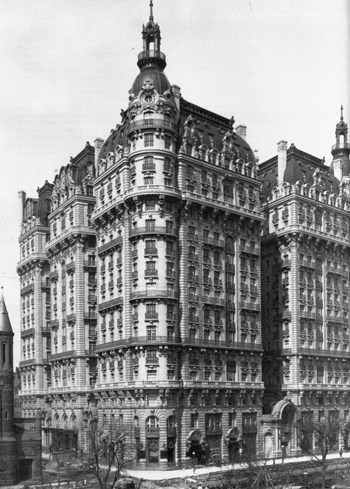
New York City is filled with exciting and inventive architectural styles. There are many different schools of thought represented in the dense mix of office, residential, and commercial buildings on the island of Manhattan and throughout the boroughs, and each site may have been occupied by a succession of buildings, each reflecting the changing needs and expectations of their times. The skyline, made up of the outlines of these various buildings, is instantly recognizable, but recognizing the individual features can be a challenge to the untrained eye.
Unique New York
"The first thing [distinguishing New York] is the height and the density," says Jim Crispino, AIA, president of Francis Cauffman Architects in Manhattan. "You just don't see these kinds of residential high-rise buildings in other places. These buildings tend to make street walls and park walls. They work well together to define the urban spaces of New York City."
Other cities developed at the same time as New York, Crispino continues, but they don't have such a dramatic mix. "The variety of styles is interesting, but it's not that uncommon on the East Coast to have that variety. What the others can't claim is the height, and the density."
The fact that Manhattan is bounded by water on all sides gives developers only one choice when trying to expand the limits of the city: up. "There might be one or two other cities in the U.S. and only a few in other parts of the world that achieve such building density and street wall in the same way that you do in New York," says Crispino. "Hong Kong and a couple of cities in China come close."
Crispino says New York neighborhoods don't usually discriminate, architecturally speaking. "There is usually a mix of residential and office or mixed-use buildings, such as in Bryant Park. New York is a large collection of small neighborhoods. Even in the East Village there is a large diversity in style."
Historically Speaking
As New York grew into a major city, farms gave way to row houses, which became mansions, then large commercial buildings, and most recently, sleek skyscrapers—at least where the island's bedrock is exposed and strong enough to hold them up.
Around the turn of the last century, developers tried to lure urban homeowners into cooperative living. "The heyday of New York apartment house design was probably 1910 to 1930, and perhaps a little earlier," says Robert Cane, of Robert Cane Architects, PLLC in Manhattan. "In those you might find some unusual styles, like French Mansard roofs." (One example of the Mansard roof is atop The Manhasset, at Broadway, between 108th and 109th Streets.)
The terms Italian Renaissance and Neoclassical are often associated with this era of architects, most notably Emery Roth, the architect of such landmark buildings as the San Remo and The Beresford on Central Park West. Roth was a Hungarian-American architect who built many of the definitive hotels and apartment buildings of the 1920s and '30s, incorporating Beaux-Arts and Art-Deco details.
According to Cane, "Buildings like the San Remo and The Eldorado represent a particular type—the twin tower—that developed on the West Side because they had a full block front. They could develop these twin towers, which get terrific light, air, exposure, and views. Typically, these buildings had a limestone base of two or three stories and a decorative entrance that might include some classical elements. Above, you would have balconies with classical railings and stone balusters."
"Later in the 1930s, in the Art Deco period," continues Cane, "you have a carrying on of that tradition in the Majestic, the El Dorado, and the Century, which is a prime example of the period. I really love the Art Deco twin tower buildings on Central Park West. Those are wonderful buildings with great detailing, ornamented with zigzags and chevrons."
"The big clusters of buildings tend to be the postwar high-rises like the Bedford Stuyvesant," says Crispino. "The shapes of the buildings don't necessarily relate to the street wall. They try to make their own internal spaces, which is somewhat unusual for New York. Even the modern high-rises that are being built today tend to hold the street wall."
Continuing that line of thought, Crispino says that "There is a recognition today about the what makes a high-rise residential building work in New York that wasn't there in the '60s and '70s." He also notes that urban planning went through several phases in the 20th century, and one set of ideas came from France.
"It came from the notion of Le Corbusier [a Swiss architect, designer and urban planner]…he had the ideas about garden cities, and that the city itself could be a green plain. At that time, there was a movement to rethink the city and the grid and the architecture, and it introduced many new forms that were very interesting architecturally, but that were rather contrarian from an urban planning point of view. Buildings were turned at an angle from the grid to make their own statement or their own oasis in the city."
Some of the decorative elements used in ornate older buildings can actually be hazardous, and have needed rethinking on occasion, says Cane. "On the Upper West Side, in the '70s or '80s, a Columbia student was killed by a falling piece of cornice from a building. Local Law 11 was born out of that incident, and in an effort to avoid liability, balconies and cornices were removed. These days, some of these buildings have tried to restore these elements using modern materials such as fiber reinforced polyester, or FRP."
New York City enacted Local Law 10 of 1980 (later amended as Local Law 11 in 1998) after the tragic incident. The law requires that facades and exterior walls of all buildings six stories and up be inspected in five-year intervals.
Recognizing Features
"Most of the modern high rise residential towers in the neoclassical style were based on buildings that were nowhere near the scale of their modern incarnations," says Crispino. "Two- or three-story buildings that are copied in New York are done on a scale of 15 to 40 stories. They have large, arched openings also done with crown moldings, entablature, and a strong base. The upper four or five floors are highly decorative, and between the base and the crown is a relatively unadorned shaft."
"Art Deco detailing can be found on such buildings as the Chrysler Building, the top of the Empire State Building, and Radio City," says Cane. "You can recognize the Jazz Age styling, and elements of stainless steel, even though they were still using limestone and brick at the base of these buildings."
"The Flatiron Building is a stylized Neoclassical," says Crispino. "The sides are relatively smooth. The window openings are really punched, or cut into the building. It 's a favorite because of its unapologetic adherence to the triangular lot that dictated its shape. It's classic New York ingenuity. It's a vertical extension of that pie-shaped lot."
"Beaux Arts and Neoclassical are terms that are often used in the same breath," says Cane. "Grand Central Terminal, the New York Public Library on Fifth Avenue, and the Metropolitan Museum are at the height of the Beaux Arts style: they have the richest classical detailing, columns, and pediments based on Roman or Greek precedents. For the most part, you could call these buildings Neoclassical. If there are not columns directly, you may see engaged columns or pilasters that are projected from another surface, as opposed to full columns that stand independently."
Here in New York, even the buildings are part of the great melting pot. "In the East Village, there are three-, four-, and five-story brick Georgian buildings that have a parapet at the top, which is essentially a giant crown molding," says Crispino. "The window heads have limestone headers or bricks that are turned in the wrong direction. These Georgian buildings have classical details, but they're brick buildings."
One of the best examples of Gothic style is the Alwyn Court, at 58th and Seventh Avenue," says Cane. "It's ornate terra cotta, probably built at the turn of the century. It's an unique New York building."
Blunders
Of course, a "unique" building doesn't automatically become a beloved building—and New Yorkers are a legendarily contrary lot when it comes to questions of taste and city planning. For every building that goes up, chances are there will be a chorus of disapproval to balance out the boosters. Neighborhood groups concerned with issues of scale and neighborhood character are often vocal opponents of single projects as well as large, sweeping development plans.
According to Peter Gisolfi of Manhattan's Peter Gisolfi Architects, not all innovations are heralded for progress—and sometimes the architecture is more a function of zoning law than what's pleasing to the public eye. "When the GM Tower replaced the Savoy Hotel in the late 1960s, it was allowed to be higher than other buildings because it allowed for a public plaza, taking advantage of a 1961 zoning resolution. The tower was monolithic, extremely tall, and had a sunken plaza, which destroyed the outdoor room effect of the Grand Army Plaza, which was right across the street, and previously made use of the Savoy Hotel's façade as a street wall."
Indeed, after reviewing the plans, Ada Louise Huxtable, architecture critic for The New York Times, called it a "sick planning joke."
Before they were lost in the 9/11 attacks, "The World Trade Center towers were criticized for being too plain, not very elegant," says Cane, "That wasn't universal, but some people were also shocked by the sheer scale."
Current Trends
One of the most obvious changes in recent New York architecture is the widespread use of glass for exteriors. According to Crispino, there are a couple of reasons why. "There is a recognition that it is very important to admit a lot of light into the living space," he explains. "It has to do with the quality of natural light and views. It's one of the reasons that the old warehouses in Soho have become so popular as living spaces. They have floor-to-ceiling heights that can be 12 to 15 feet. There is a draw to overhead space, and a feeling of spaciousness that can make even a small apartment feel much larger."
"Some of the glass curtain wall buildings going up around the city are not in context with buildings around them, which are roughly the same height, about 15 stories, but made of masonry," says Cane, alluding to one of the perennial complaints of neighborhood organizations dealing with new development on their blocks. "These buildings are probably 30 to 40 stories of glass curtain wall, and I think it has been a shock to the neighborhoods."
And, continues Cane, another reason glass is getting so much attention is the cost. "Where it used to be prohibitively expensive, glass is now closer to masonry, making it a more popular building material. In the 1980s and '90s, new buildings were brick. Glass is also more fashionable. It allows more light and air, and it can be very beautiful."
Some of these new buildings may become famous in their own right, says Cane. "The Richard Meier buildings down on West Street might become glass icons, even though they went through a lot of criticism for being too transparent."
From the earliest wooden homes to today's ultra-modern glass-and-steel (or even titanium) high-rises, New York City's architecture has distinguished itself through sheer variety stacked vertically atop whatever was in fashion just a few years ago. One thing's for sure: The architectural face of New York City is as varied and changeable as the city's population itself.
Denton Tarver is a freelance writer, teacher, and landscape architect-in-training living in New York City.






Leave a Comment